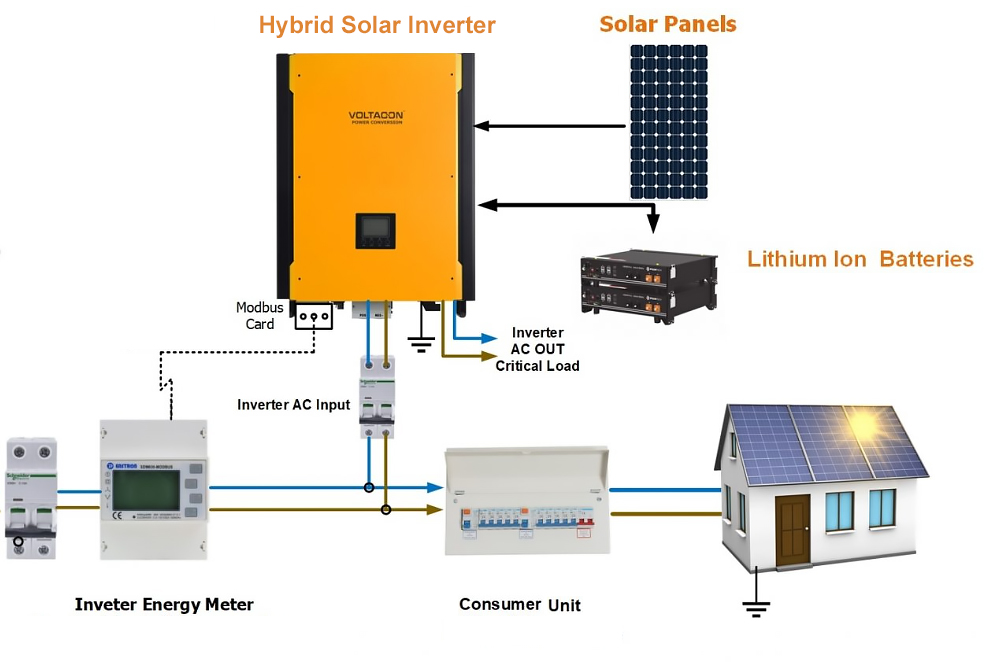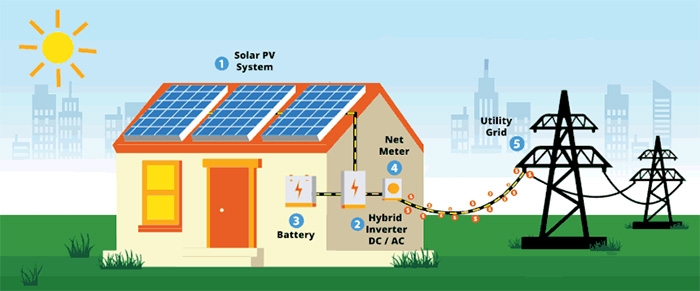Against the backdrop of today's global energy transition, grid-connected photovoltaic (PV) systems, as an important component of renewable energy, are gradually penetrating various fields such as homes, warehouses, and commercial buildings, aiming to reduce dependence on fossil fuels and promote the greening of the energy mix. Hybrid solar inverters, as a key component in this system, provide strong support for maximizing the use of PV power with their efficient and intelligent energy management features.
In this article, Inverter.com will discuss how grid-connected photovoltaic systems can work closely with hybrid solar inverters to achieve energy self-sufficiency and high efficiency from a professional point of view.
Overview of grid-connected photovoltaic systems
Grid-connected PV system, as the name suggests, refers to connecting the PV power generation system to the public power grid to achieve a two-way flow of electricity. The system mainly consists of solar panels, hybrid solar inverters, energy storage batteries (e.g. lithium battery packs), intelligent control systems, and connecting cables. The working principle is to convert solar energy into direct current through solar panels, and then convert it into alternating current with the same frequency and phase as the power grid by a hybrid solar inverter for internal use in the family or building, and to send power to the power grid when there is a surplus; when the photovoltaic power is insufficient, it will automatically take power from the power grid to ensure the continuity and stability of the power supply.

What's the core function of hybrid solar inverters?
A hybrid solar inverter, as the ‘heart’ of the grid-connected PV system, is responsible for the conversion of electricity and undertakes multiple tasks such as energy management, grid synchronization, protection, and control. Its main features include:
- High-efficiency power conversion: adopting advanced power electronics technology to achieve high-efficiency conversion from DC to AC and reduce energy loss.
- Intelligent energy management: according to the PV power generation, load demand, and the state of the energy storage battery, it intelligently adjusts the ratio of grid and PV power to achieve the optimal allocation of energy.
- Grid Synchronisation Function: Ensure that the AC power output from the inverter is consistent with the grid voltage and frequency to achieve seamless grid integration.
- Safety protection mechanism: including over-voltage protection, under-voltage protection, short-circuit protection, etc., to ensure safe and stable operation of the system.
- Energy storage battery management: monitor battery status, optimize charging and discharging strategies, and extend battery life.
Synergistic strategies for grid-connected PV systems with hybrid solar inverters
- Energy optimization scheduling: The hybrid solar inverter dynamically adjusts the energy use strategy through the built-in intelligent algorithm that monitors real-time information on PV power generation, load demand, and grid electricity price. When there is sufficient light, priority is given to using PV power to supply electricity and excess power is deposited into the storage battery as much as possible; when PV power is insufficient, intelligent choices are made to purchase power from the grid or discharge power from the battery according to the grid electricity price and battery power, to achieve the minimization of energy costs.
- Intelligent charging and discharging of the storage battery: The hybrid solar inverter can intelligently control the charging and discharging process of the battery according to the battery status (e.g., SOC, i.e., the percentage of remaining battery power) and the grid electricity price. When the grid electricity price is low, the battery charging is increased to store low-cost electricity; during the peak electricity price, the power purchased from the grid is reduced, and the battery is discharged for power supply instead, thus reducing the cost of electricity consumption. At the same time, the inverter will also take into account the battery life factor, to avoid overcharging and over-discharging, to extend the battery life.
- Flexible switching between grid-connected and off-grid: Although grid-connected PV systems are usually designed to operate in parallel with the grid, under certain special circumstances (e.g., grid faults, blackouts, etc.), hybrid solar inverters should have the ability to operate off-grid. When a grid anomaly is detected, the on-grid inverter can quickly switch to off-grid mode, utilizing the PV power and storage batteries to power the loads and ensure continuous operation of critical equipment. When the grid returns to normal, the inverter can automatically switch back to the grid-connected mode, achieving a seamless transition.
- Remote monitoring and troubleshooting: Modern hybrid solar inverters generally support remote monitoring functions, allowing users to view system operation status, power generation, energy consumption, and other data in real time via mobile phone apps or web platforms. At the same time, the inverters are also equipped with troubleshooting and early warning functions. Once abnormal conditions (such as battery failure, grid fluctuations, etc.) are detected, the inverters can immediately issue an alarm and provide troubleshooting suggestions to help users solve problems on time.
Case Analysis: Optimization Practice of Grid-connected PV System in a Commercial Building
Take a large commercial building as an example. The building is equipped with a grid-connected photovoltaic system with a total capacity of 500kW and is equipped with advanced hybrid solar inverters for energy management. By implementing the following optimization strategies, the building has achieved remarkable results in energy self-sufficiency and cost savings:
- Intelligent scheduling strategy: formulate personalized power consumption plans based on the differences in power demand in different areas of the building. During peak hours during the day, solar panels, photovoltaic power, and energy storage batteries are used for power supply; during low-peak hours at night, energy storage batteries are charged during the preferential power price period of the grid.
- Optimized configuration of energy storage batteries: According to historical power consumption data and future forecast trends, the capacity and charging and discharging strategies of energy storage batteries are reasonably configured. Under the premise of ensuring the normal power demand of the building, the utilization rate and economic benefits of energy storage batteries are maximized.
- Remote monitoring and maintenance: Establish a remote monitoring center to monitor the operating status of the photovoltaic system and inverter in real-time. Through data analysis, potential problems are discovered in time, and preventive maintenance is carried out to ensure the long-term stable operation of the system.
The synergistic application of grid-connected photovoltaic (PV) systems and hybrid solar inverters provides strong support for the efficient use of solar energy and the greening of the energy mix. With continuous technological advancement and cost reduction, this system will be widely applied in more fields to promote global energy transition and sustainable development.
The synergistic application of grid-connected photovoltaic systems and hybrid solar inverters is an important way to achieve the efficient use of solar energy and the greening of the energy mix. In the future, with the continuous progress of technology and market development, this system will be widely used in more fields. To promote its healthy development, Inverter.com suggests that governments, enterprises, and research institutes should strengthen cooperation and jointly promote technological innovation and industrial upgrading; at the same time, policy guidance and market cultivation should be strengthened to improve market acceptance and awareness; in addition, attention should be paid to issues such as grid access and scheduling, to ensure that the coordinated operation of distributed energy sources and the grid is ensured. Through the efforts of many parties, we can jointly promote global energy transformation and sustainable development.

